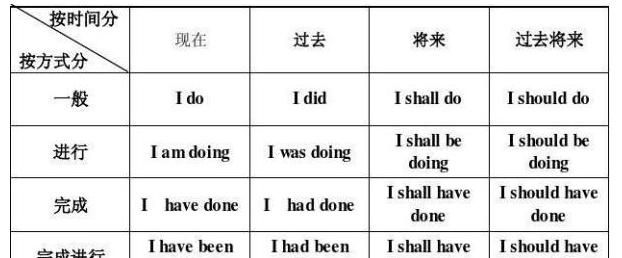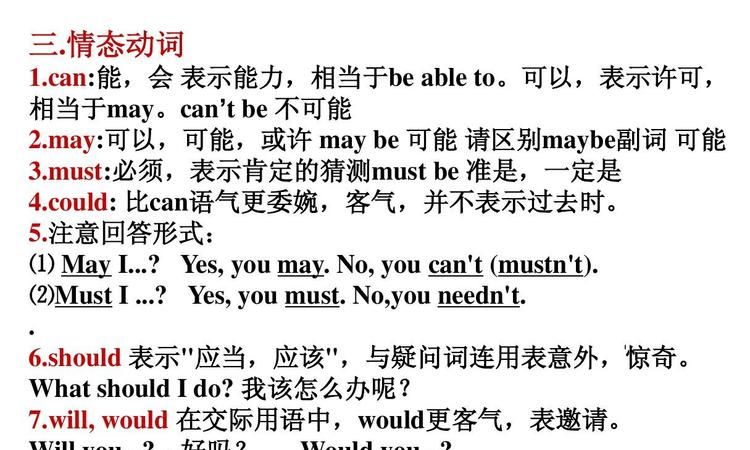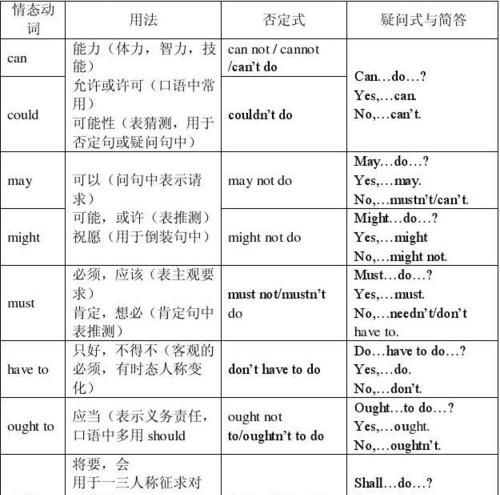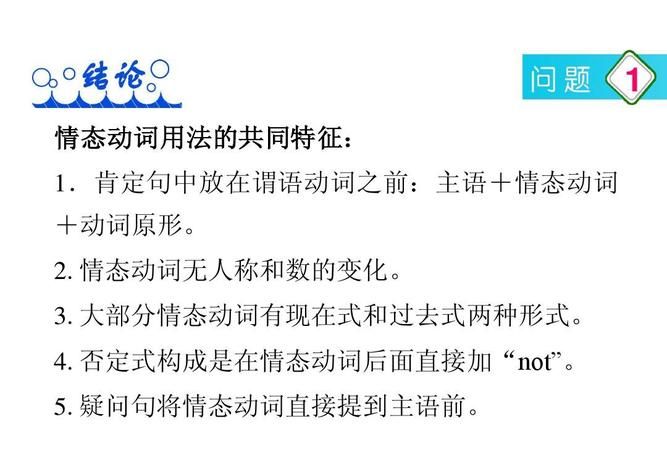本文目录
情态动词的用法
情态动词
+
动词原形do;
情态动词
+
动词完成进行时have
been
doing;
情态动词
+
动词完成时have
done
1)
不管哪一种形式,情态动词的词义都在句中起作用。
2)
情态动词的过去时、现在时没有太大的时间性区别,只是情态动词的过去时用得相对较多,语气比现在时更客气、委婉、缓和。
3)
都表示在一定时间(现在或过去)对发生和出现的事情进行推测、猜测、判断等。
a)
对现在的事情进行把握较大的判断时
肯定判断一般用must加动词原形,此时,must不再表示“必须”,而是表示“肯定”。
否定判断时一般用can't加动词原形,此时,can不再表示“能够”,而是表示“肯定不……、肯定没有……”。
c)
对现在的事情进行把握较小的判断
肯定一般用may加动词原形,此时,may不再表示“可以”,而是表示“可能”。
否定判断时一般用may
not加动词原形。
she
may
not
be
annoyed
because
she
is
very
patient.(她可能不会烦躁,因为她很有耐心。)
d)
对现在的事情进行把握更小的判断
肯定判断一般用might加动词原形;
否定判断时一般用might
not加动词原形。
she
might
not
be
annoyed
because
she
usually
is
very
patient.(她可能不会烦躁,因为她通常很有耐心。)
e)
对过去的事情进行把握较小的判断时一般用may加动词的完成时形式(may
have
done),同样,may不再表示“可以”,而是表示“可能”。对过去事情进行把握较小的否定判断时一般用加动词的完成时形式(may
not
have
done)。
f)
对过去的事情进行把握更小的判断
肯定判断一般用might加动词的完成时形式(might
have
done);
1)
用于表示“应该”或“不应该”的概念。此时常指长辈教导或责备晚辈:
2)
用于提出意见劝导别人:
3)
委婉地对别人提出建议或劝告通常用i
should
/
shouldn't
……if
i
were
you句型:
4)
用于表示可能性。should的这一用法是考试中常常出现的考点之一:
5)
在以in
case或
if引导的从句中,常用should表达一定程度的可能性。
6)
用于表示一种惊讶的语气,should的这一用法也是考试中常常出现的考点之一:

含有情态动词can的肯定句
1.肯定句型为:主语+can+动词原形+其它。例如: They can play basketball.他们能打篮球。 She can dance.她会跳舞。
You can go to watch TV.你可以去看电视了。
2.
否定句型为
:
主语
+can not(can't/cannot)+
动词原形
+
其它。表示
"
某人不能
(
不会。不可
能
)
做……
"
。其中
can't
是
can not
的缩略式
,
英国多写成
cannot
。例如
:
You cannot pass the ball like this.
你不能像这样传球。
I can't ride a motorbike.
我不会骑摩托车。
3.疑问句句型分为:一般疑问句句型和特殊疑问句句型两种类型。 ⑴一般疑问句句型为:Can+主语+动词原形+其它。表示"某人会(能。可以)做……吗?",用于口语时,常表示请求或许可。其肯定答语用""Yes,主语+can."作答;否定答语用"No,主语+can't."作答。注意答语中作主语的人称代词,应根据问句中的主语作相应的变化。其变化规则为:第一人称问,则第二人称答;第二人称问,则第一人称答;第三人称问,第三人称答。

动名词的肯定形式和否定形式
回答:1. 系动词be的肯定与否定:be(is, am , are,was, were) +表语(名词、代词、形容词、数词、某些副词、动名词、分词、不定式、介词短语、表语从句、疑问词+不定式、表语从句等);be +not +表语。 例如:
He is a doctor. He is not / isnt a doctor.
I was late yesterday. I was not late yesterday.
His job is tending / to tend the old man.
其他系动词的肯定与否定:助动词、情态动词+系动词原形+表语;助动词、情态动词+系动词原形+表语。例如:
He does look thin. He does not / doesn't look thin.
The city will become one full of life in five years. The city will not / won't become one full of life in five years.
The room must keep clean. The room need not / keep clean.
2. 助动词、情态动词的肯定与否定:助动词、情态动词+动词原形; 助动词、情态动词+not +动词原形。例如:
We do know it. We do not /don't know it.
They will be back soon. They will not / won't come back soon.
He can swim. He can not / can't swim.

英语情态动词的否定形式是什么
情态动词无人称和数的变化, 情态动词后面跟的动词需用原形,否定式构成是在情态动词后面加 "not"。 个别情态动词有现在式和过去式两种形式, 过去式用来表达更加客气, 委婉的语气, 时态性不强, 可用于过去,现在或将来。情态动词属非及物动词,故没有被动语态。
He could be here soon.
他很快就来。
We can't carry the heavy box.
我们搬不动那箱子。
I'm sorry I can't help you.
对不起,我帮不上你。
除此之外,情态助动词还有如下词法和句法特征:
1) 除ought和used以外,其他情态动词后面只能接不带to的不定式。如果我们把ought to和used to看做是固定词组的话,那么,所有情态动词无一例外地只能接不带to的不定式:
We used to grow beautiful roses.
I asked if he would come and repair my television set.
2) 情态助动词在限定动词词组总是位居第一:
They need not have been punished so severely.
3) 情态助动词用于第三人称单数现在时的时候,没有词形变化,即其词尾无-s形式:
She dare not say what she thinks.
4) 情态动词没有非限定形式,即没有不定式和分词形式,也没有相应的动名词:
Still, she needn't have run away.
5) 情态助动词的“时”的形式并不是时间区别的主要标志。在不少场合,情态助动词的现在时和过去时形式都可以表示现在、过去或将来时间:
Would you mind very much if I ask you to do something?
She told him he ought not to have done it.
6) 情态助动词之间是相互排斥的,即在一个限定动词词组中只能出现一个情态助动词,但有时却可以与have和be基本助动词连用:
You should have washed the wound.
Well, you shouldn't be reading a novel.
情态动词数量不多,但用途广泛,主要有下列:
can (could), may (might), must, need, ought to, dare (dared), shall (should), will (would),have (to) ,had better,would rather.
can和could的用法
1. 表示能力或客观可能性,还可以表示请求和允许。如:
Can you finish this work tonight?
Man cannot live without air.
— Can I go now? — Yes, you can.
注意:①could也可表示请求,预期委婉,主要用于疑问句,不可用于肯定句,答语应用can(即could不能用于现在时态的简略答语中)。如:
Could I come to see you tomorrow?
Yes, you can. (否定答语可用No, I'm afraid not.)
②can表示能力时,还可用be able to代替。如:
I'll not be able to come this afternoon.
2. 表示惊异、怀疑、不相信的态度。(主要用在否定句、疑问句或惊叹句中)
Can this be true?
How can you be so careless!
This cannot be done by him.
3. “can(could) + have + 过去分词”的疑问或否定形式表示对过去发生的行为怀疑或不肯定。如:
He cannot have been to that town.
Can he have got the book?
4. 用在疑问句及否定句中,表示惊讶,不相信等.
5. cannot```too\enough表示"无论怎样``````也不过分","越``````越好"
may和might的用法
1. 表示许可。
表示请求、允许时,might比many的语气更委婉一些,否定回答时要用mustn't表示“不可以”、“禁止”、“阻止”之意。如:
You may drive the car.
— Might I use your pen? — No, you mustn't.
用May I ... 征询对方许可在文体上比较正式,在口气上比较客气。在日常口语中,用Can I ... 征询对方意见在现代口语中更为常见。
2. 用于祈使句中表示祝愿。如:
May you succeed!
3. 表示推测、可能(疑问句不能用于此意)。
He may be very busy now.
4. “may(might) + have + 过去分词”表示对过去发生的行为的推测。如:
He may not have finished the work.
must和have to的用法
1. 表示必须、必要。(must表示主观多一些而have to则表示客观多一些)如:
You must come in time.
回答must引出的问句时,如果是否定的回答,不能用mustn't,而要用needn't或don't have to。
— Must we hand in our exercise books today?
— Yes, you must. (No, you don’t have to.)
2. “must be + 表语”的结构表示推测,它的否定或疑问式用can代替must。
This must be your pen.
3. “must + have + 过去分词”的结构常用在肯定句中,表示对过去发生的行为的推测。它的否定或疑问式用can代替must。
He must have been to Shanghai.
4. have to的含义与must相似,两者往往可以互换使用,但have to有各种形式,随have的变化而定。must与have to有下列几点不同:
① must表示的是说话人的主观看法,而have to则往往强调客观需要。如:
The play is not interesting. I really must go now.
I had to work when I was your age.
② must一般只表现在,have则有更多的时态形式。
③ 二者的否定意义不大相同。如:
You mustn't go. 你可不要去。
You don't have to go. 你不必去。
④ 询问对方的意愿时应用must。如:
Must I clean all the room?
dare和need的用法
1. need表示“需要”或“必须”,作情态动词时,仅用于否定句或疑问句中,在肯定句中一般用must, have to, ought to,或should代替。如:
You needn’t come so early.
— Need I finish the work today?
— Yes, you must.
注意:needn't + 不定式的完成式“表示本来不必做某事而实际上做了某事”。如:
You needn't have waited for me.
2. Dare作情态动词时,主要用于疑问句、否定句和条件从句中,一般不用在肯定句中。如:
How dare you say I'm unfair.
He daren't speak English before such a crowd, dare he?
3. Dare和need常用作实义动词,有时态、人称和数的变化,所不同的是,作实义动词时,在肯定句中,dare后面通常接带to的不定式,在否定和疑问句中,dare后面可接带to或不带to的不定式。如:
I dare to swim across this river.
He does not dare (to) answer.
Don't you dare (to) touch it!
I wondered he dare (to) say that.
He needs to finish it this evening.
shall和should的用法
1. Shall用于第一人称,表示征求对方的意愿。如:
What shall we do this evening?
2. Shall用于第一、第三人称疑问句中,表示说话人征求对方的意见或向对方请示。如:
Shall we begin our lesson?
When shall he be able to leave the hospital?
3. Shall用于第二、第三人称,表示说话人给对方命令、警告、允诺或威胁。如:
You shall fail if you don't work harder. (警告)
He shall have the book when I finish reading. (允诺)
He shall be punished. (威胁)
4. Should表示劝告、建议、命令,其同义词是ought to;在疑问句中,通常用should代替ought to。如:
You should go to class right away.
Should I open the window?
Should的含义较多,用法较活,现介绍三种其特殊用法。请看下面的句子:
① I should think it would be better to try it again. 我倒是认为最好再试一试。
② You are mistaken, I should say. 依我看,你是搞错了。
③ I should advise you not to do that. 我倒是劝你别这样做。
④ This is something I should have liked to ask you. 这是我本来想问你的。
从以上例句可以看出:情态动词should用于第一人称时可以表示说话人的一种谦逊、客气、委婉的语气。
Should还可以用在if引导的条件从句,表示一件事听起来可能性很小,但也不是完全没有可能。相当于“万一”的意思。从句谓语由should加动词原形构成,主句谓语却不一定用虚拟语气。如:
⑤ Ask her to ring me up if you should see her. 你万一见到她,请让她给我打个电话。
⑥ If you should change your mind, please let us know. 万一你改变主意,请通知我们。
⑦ Should I (If I should) be free tomorrow I will come. 万一我明天有时间,我就来。
此外,Why(or How) + should结构表示说话人对某事不能理解,感到意外、惊异等意思。意为“竟会”。如:
⑧ Why should you be so late today? 你几天怎么来得这么晚?
⑨ — Where is Betty living? — 贝蒂住在哪里?
— How should I know? — 我怎么会知道呢?
⑩ I don't know why you should think that I did it. 我真不知道你凭什么认为这件事是我干的。
5. “should + have + 过去分词”结构一般表示义务,表示应该做到而实际上没有做到,并包含一种埋怨、责备的口气。如: She should have finished it.
I should have helped her, but I never could.
You should have started earlier.
will和would的用法
1. 表示请求、建议等,would比will委婉客气。如:
Would you pass me the book?
2. 表示意志、愿望和决心。如:
I will never do that again.
They asked if we would do that again.
3. 用“will be”和“will(would) + have + 过去分词”的结构表示推测,主要用于第二、三人称。前者表示对目前情况的推测,后者表示对已经完成的动作或事态的推测。如:
This will be the book you want.
He will have arrived by now.
The guests would have arrived by that time.
I thought you would have finished this by now.
4. Would可表示过去反复发生的动作或某中倾向。Would表过去习惯时比used to正式,并没有“现已无此习惯”的含义。如:
The wound would not heal.
During the vacation he would visit me every week.
5. 表料想或猜想。如:
It would be about ten when he left home.
What would she be doing there?
I thought he would have told you all about it.
ought to的用法
1. Ought to表示应该。如:
You ought to take care of him.
2. 表示推测。注意与must表示推测时的区别:
He must be at home by now. (断定他已到家)
He ought to be home by now. (不十分肯定)
This is where the oil must be. (比较直率)
This is where the oil ought to be. (比较含蓄)
3. “ought to + have + 过去分词”表示过去应做某事而实际未做。如:
You ought to have asked him (but you didn't).
这时,ought to和should可以互相换用。
注意:在美国英语中,ought to用于否定句和疑问句时,to可以省略。如:
Ought you smoke so much?
You oughtn't smoke so much.
used to,had better,would rather的用法
1. Used to表示过去的习惯动作或状态,现在已不存在,在间接引语中,其形式可不变。如:
He told us he used to play football when he was young.
在疑问句、否定句、否定疑问句或强调句中,可有两种形式:
疑问句
Did you use to go to the same school as your brother?
Used you to go to the same school as your brother?
否定句
I usedn't to go there.
I didn't use to go there.
Usedn't 亦可拼作usen't,但发音皆为[ju:znt]。
否定疑问句
Usen't you to be interested in the theatre?
Didn't you use to be interested in the theatre?
强调句
I certainly used to smoke, but it was a long time ago.
I certainly did use to smoke, but it was a long time ago.
其反意疑问句或简略回答中,也有两种形式:
She used to be very fat, didn't she? (正式)/ use(d)n't she? (口语)
Did you use to play chess? Yes, I did.
Used you to get up early in the morning? Yes, I did. (Yes, I used to.)
2. Had better意为“最好”,后接不带to的不定式。如:
— We had better go now.
— Yes, we had (we'd better / we had better).
Hadn't we better stop now? (Had we better not stop now?)
I think I'd better be going. (用于进行时态,表“最好立即”)
You had better have done that. (用于完成时态,表未完成动作)
注:①had best与had better同意,但较少用。②You had better … 用于同辈或小辈,对长辈不可用。
3. Would rather意为“宁愿”,表选择,后接不带to的不定式。如:
I'd rather not say anything.
Would you rather work on a farm?
— Wouldn't you rather stay here?
— No, I would not. I'd rather go there.
由于would rather表选择,因而后可接than。如:
I would rather work on a farm than in a factory.
I would rather watch TV than go to see the film.
I would rather lose a dozen cherry trees than that you should tell me one lie.
I'd rather you didn't talk about this to anyone. (句中的'd rather不是情态动词,would在此是表愿望的实义动词)
希望对您有帮助。

以上就是关于情态动词的肯定形式 ,情态动词的用法的全部内容,以及情态动词的肯定形式 的相关内容,希望能够帮到您。
